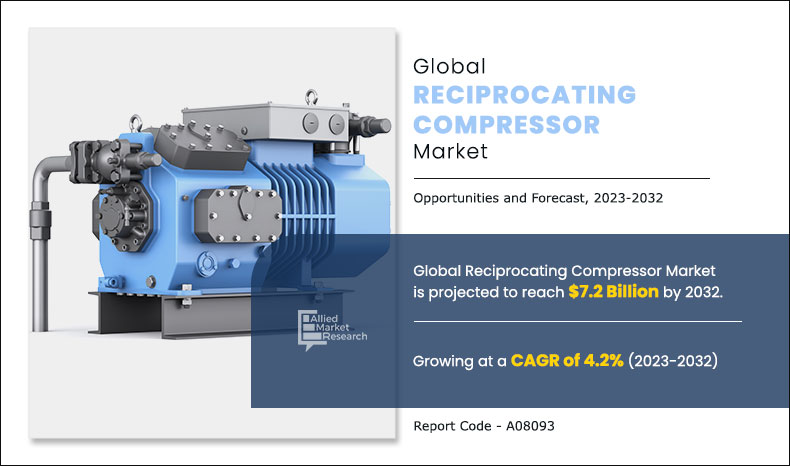Reciprocating Compressor Market Research, 2032
The Global Reciprocating Compressor Market Size was valued at $4.9 billion in 2022, and is projected to reach $7.2 billion by 2032, growing at a CAGR of 4.2% from 2023 to 2032.
Reciprocating compressor, also known as a piston compressor, is a positive displacement device. It is one of the most widely used types of compressors in which gas is compressed by reciprocating motion of a piston. It handles a low mass of gas but high-pressure ratio. During the operation of reciprocating compression, it takes a large amount of gas from the suction line.
Reciprocating Compressor Market Dynamics
Reciprocating Compression is a mechanism that is intended to shrink the volume of the gases which actually occurs by compressing the gases. It is attained through a sequence of yoking of an individual piston which firmly fits in cylinder.. Presumably the motion of the piston is reversed cyclicallyly it compresses and expands the gas between times. The gas in the cylinder is compressed during the compression stroke, due to decrease in volume it causes the elevation of both pressure and temperature in the cylinder.
Gas is finally squeezed away to a gate value, where it may be stored in a tank or sent to another point of exit for further usage or transmission. Reciprocating compressors are among the most ubiquitous pieces of equipment in industrial settings with their use ranging from home refrigeration and air conditioning to natural gas processing and petroleum refining. Their range of abilities as well as the trustworthiness and ability to deal with various gaseous compositions and operation modes is a determinant factor in what they are loved for. Although it should be taken into account that they can frequently need maintenance and compared to other compressor types, they are in most cases noisy.
A reciprocating compressor market is divided by type, stage, end user and the region they are used. Depending on the type, the global market is segmented into single acting, double acting and diaphragm category. Differentiated according to the stages involved with the classification of a single stage or multi-stage rocket. Oil and gas, pharmaceutical, chemical plants, refrigeration plants, manufacturing, automotive, food, and others are the primary end users for this market as per the usage survey by the consumers. Among the key geographic areas the market landscape is explained in North America, Europe, Asia-Pacific and LAMEA.
The trend in the reciprocating compressor market is mainly triggered off by the amplifying demand across the oil and gas, manufacturing, and car sectors. These compressors (as the most needed equipment for high-pressure gas compression applications) are used in such processes as transporting gas, refrigeration, and compressing air tools.
Besides, the market is driven by technology which in turn serves as a source of inventions and discoveries of more stable and a reliable types of reciprocating compressor units. Thus, Ariel Corporation and Hoerbiger in their formermanifesto, which dismissed them as the world's biggest manufacturer of separable gas compressors and a global leader in gas compressor component technology respectively, agreed to manufacture non-lube compressor solutions to satisfy the hydrogen compression needs for the future hydrogen mobility market such as public transits, large fleet vehicles, private companies, trains, ships/boats,
In addition the increase in energy efficiency and sustainability awareness within the industry not only accelerates the growth of the market, it provides an opportunity to improve the energy consumption of the reciprocation compressors. Still, problems like need for frequent maintenance and the loudness of the technology may hinder the market growth. To help break the barrier toward a boom in the use of this technology, new inventions will need to be made that will address these problems.
It is then compressed by the reciprocation motion of the piston driven by the crankshaft, and then it discharges the compressed gas to the discharge line. These compressors are used in the manufacturing of chemicals and petroleum. They are used in processes that comprise use in the transportation of natural gas and compression of gas. In addition to that, reciprocating compressors find their use in a wide range of processes in various industrial sectors such as pharmaceuticals, power generation, metal processing, oil and gas, and chemicals.
A rise in the demand for reciprocating compressors from CNG and LNG transport and storage plants and refinery are creating the demand for reciprocating compressors market growth. It offers various features such as excellent performance in both high pressure and power. Reciprocating compressors are extensively used in the production of chemicals and petroleum, including natural gas transportation and gas compression. Also, reciprocating compressors have their use in industrial sectors, including oil & gas, chemicals, refrigeration, metal processing, power generation, and pharmaceutical industries. In addition, growth associated with the oil industry and natural gas production is a prominent factor that may fuel the reciprocating compressor market demand during the forecast period.
According to EIA's Annual Energy Outlook, U.S. crude output is going to increase by 20% by 2030, and the demand for natural gas is estimated to attain around 15.6% of growth over the next few years. Further, expenditure by the U.S. oil and gas companies is expected to increase during the forecast period. Natural gas is gaining importance as the preferred fuel option, owing to its low emission and low-cost properties. Air compressors have wide-scale applications in the oil and mining industries, which may act as a driver for the air compressor industry.
All such factors are expected to boost the reciprocating compressor market growth. However, the high initial investments and maintenance costs are likely to emerge as restraining factors for the global reciprocating compressor market. On the contrary, the rise in technological advancements in reciprocating compressor is anticipated to provide lucrative opportunities for the growth of the market.
The reciprocating compressor market is witnessing various obstructions in its regular operations due to the COVID-19 pandemic and inflation. Earlier, the global lockdowns resulted in reduced industrial activities, eventually leading to reduced demand for reciprocating compressor from various sectors such as construction and industrial. However, COVID-19 has subsided, and the major manufacturers in 2023 are performing well. However, rise in global inflation is a new major obstructing factor for the entire industry.
The inflation, which is a direct result of the Ukraine-Russia war, and few long-term impacts of the coronavirus pandemic, have introduced volatility in the prices of raw materials used for manufacturing reciprocating compressor. In addition, the cost of oil & gas has also increased substantially, and many countries, especially, the countries in Europe, Latin America, and developing economies in Asia-Pacific are experiencing severe negative impacts on industrial production, including the production of reciprocating compressor. However, India and China are performing relatively well. In addition, inflation is expected to worsen in the coming years, as the possibility of the ending of the war between Ukraine and Russia is less. However, a peace agreement between Ukraine and Russia can be devised, with continued talks between different countries.
Reciprocating Compressor Market Segment Overview
The reciprocating compressor market is segmented on the basis of type, stage, end user, and region. By type, the market is categorized into single acting, double acting, and diaphragm. On the basis of stage, it is bifurcated into single stage and multi stage. As per end user, the market is categorized into oil and gas, pharmaceutical, chemical plants, refrigeration plants, manufacturing, automotive, food, and others. Region wise, the market is analyzed across North America, Europe, Asia-Pacific, and LAMEA.
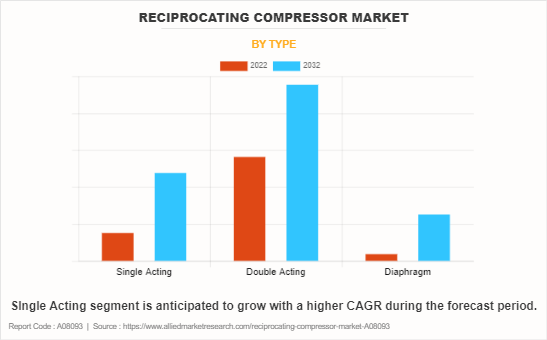
By Type:
The reciprocating compressor market is divided into single acting, double acting, and diaphragm. In 2020, the double acting segment dominated the reciprocating compressor market, in terms of revenue, and is expected to maintain this trend during the forecast period. However, the single acting segment is anticipated to grow with a higher CAGR during the forecast period. A single-acting compressor is a type of air compressor which uses only one end of the piston for the suction and compression purpose. The first stroke of the piston sucks the air inside the compressor while the air compression occur in the second stroke.
The piston upper part is used for air compression while the other side is used to open the crankcase. In addition, a single acting compressor uses compressed air to push the piston in one direction and the spring force to send the piston back to its primary position. It works in the direction of pneumatic actuators. The cylinder of these reciprocating air compressors uses only one piston for supplying and discharging pressurized gas or air. Single acting reciprocating compressor is used in hydraulic rams and pumps. Moreover, it also offers various advantages such as cost effective and ease of maintenance.
These single acting compressors are used in various applications such as borewell, chemical industries, circuit breaking, spray painting, pneumatic tools, liquid transfer, and others. All such factors are expected to boost the growth of the market during the forecast period.
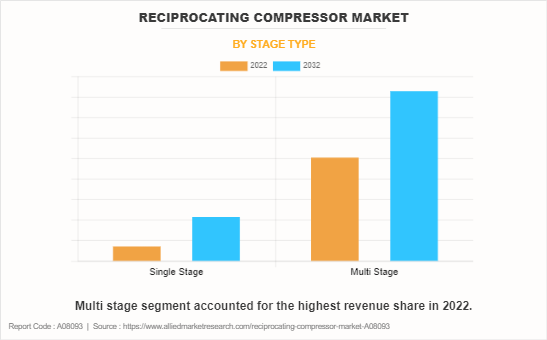
By Stage:
The reciprocating compressor market is categorized into single stage and multi stage. A single-stage reciprocating compressor is a type of compressor in which the gas or air is compressed in a single stage. This compressor uses a single cylinder and a piston for the compression of air and also, the air is compressed only one time. The body of the compressor is set according to the arrangement of the piston and cylinder. In addition, the single-stage piston compressor is operated by a pressure-measuring valve and a piston. The compression process is done through the piston.
This piston reciprocates inside the compression cylinder. A connecting rod and a crankshaft control the motion of the piston. The flywheel is installed to control the torque generated due to the crankshaft movement. In these compressors, the crankshaft drives through the engine output shaft or electric motor. Moreover, it has various applications such as workshops, auto shops, gas stations, manufacturing plants, chemical plants and others which is anticipated to boost the reciprocating compressor market growth.
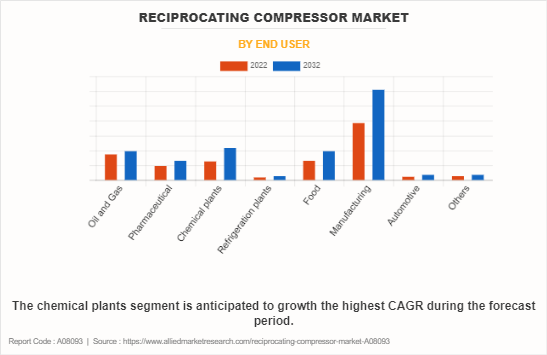
By End User:
The reciprocating compressor market is categorized into oil and gas, pharmaceutical, chemical plants, refrigeration plants, manufacturing plants, automotive industries, food, and others. Petrochemical industries are witnessing a surge owing to the rise in demand for fuel by automotive users, shippers & transporters, and the energy industry. For instance, according to the Automobile Dealer Association (NADA), sales of new light vehicles totaled at 14.93 million units in 2021, which is 3.1% more than the sales generated in 2020.
Furthermore, to meet this rising demand for fuel and energy by automotive and other industries, public and private entities across the world are constructing and developing oil and gas refineries. For instance, Angola is developing a refinery having a capacity refining 60,000 barrels of crude oil a day in its Cabinda province. It is expected to be completed by 2024 at a cost of around $900 million. Such instances and key factors are anticipated to create lucrative opportunities for the reciprocating compressor market growth.
In addition, reciprocating compressor uses a piston cylinder mechanism to compress gas for the high pressure and low pressure applications. In oil & gas industry, it is used to compress and transport gases efficiently. It is also used for the high pressure hydrogen required to remove the sulfur contained in the crude oil. All such factors are anticipated to boost the market growth.
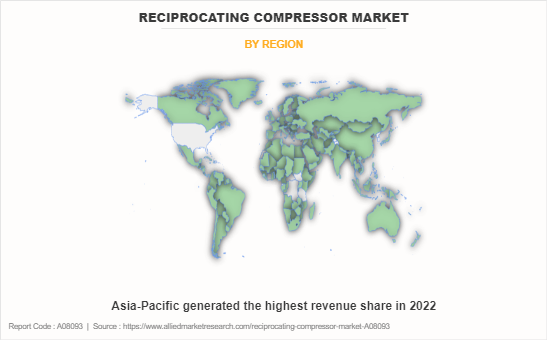
By Region:
The reciprocating compressor market is analyzed across North America, Europe, Asia-Pacific, and LAMEA. Asia-Pacific accounted for the highest market share in reciprocating compressor market share in 2022, and North America expected to maintain its dominance during the forecast period. Asia-Pacific is one of the world’s fastest-growing regions, expanding at a rate of 5% per year. Rapid industrialization has led to expansion in the manufacturing sector, which in turn has boosted the economy.
The region’s manufacturing sector is also flourishing because of the lenient industrial policies of the countries, which aim to lure foreign investment. Along with this, the rising population in the region is anticipated to create a demand for warehouses, cold storage, and other processes which requires compressed air or gas. In addition, factors such as availability of workforce and low-cost manufacturing have propelled the manufacturing sector in Asia-Pacific. The food processing and manufacturing industries are the major contributors to the GDP of countries such as Japan, South Korea, and Australia.
Furthermore, China is one of the largest providers of activated pharmaceutical ingredients, and the Indian pharmaceutical industry is witnessing substantial growth. These factors have driven the demand for reciprocating compressors in Asia-Pacific.
Moreover, various government initiatives have boosted the manufacturing sector in the region. For instance, Make in India launched by the Indian Government, and Made in China 2025 launched by the Chinese Government have fueled the growth of manufacturing sector. Furthermore, the exponential rise in population and rapid development of the manufacturing industries have fueled the demand for electricity, thereby increasing the number of power plants in the region. These factors are expected to provide lucrative opportunities for the growth of the reciprocating compressor market in the region.
Competition Analysis
Competitive analysis and profiles of the major players in the reciprocating compressor market, such as Ariel Corporation, Atlas Copco AB, Burckhardt Compression Holding AG, Gardner Denver Holdings, Inc., General Electric, Howden Group Holdings Limited, IHI Corporation, Mayekawa Mfg. Co., Ltd, SIEMENS AG, and Ingersoll Rand, are provided in this report. There are some important players in the market such as Ariel Corporation, Atlas Copco AB, and Siemens AG. Major players have adopted product launch and acquisition as key developmental strategies to improve the product portfolio of the reciprocating compressor market.
Key Benefits For Stakeholders
- The report provides an extensive analysis of the current and emerging reciprocating compressor market trends and dynamics.
- In-depth reciprocating compressor market analysis is conducted by constructing market estimations for the key market segments between 2022 and 2032.
- Extensive analysis of the reciprocating compressor market is conducted by following key product positioning and monitoring of the top competitors within the market framework.
- A comprehensive analysis of all regions is provided to determine the prevailing opportunities.
- The reciprocating compressor market forecast analysis from 2023 to 2032 is included in the report.
- The key market players within reciprocating compressor market outlook are profiled in this report and their strategies are analyzed thoroughly, which help understand the competitive outlook of the reciprocating compressor industry.
Reciprocating Compressor Market Report Highlights
| Aspects | Details |
| Market Size By 2032 | USD 7.2 billion |
| Growth Rate | CAGR of 4.2% |
| Forecast period | 2022 - 2032 |
| Report Pages | 220 |
| By Type |
|
| By Stage Type |
|
| By End User |
|
| By Region |
|
| Key Market Players | Burckhardt Compression Holding AG, IHI Corporation, General Electric, SIEMENS AG, Howden Group Holdings Limited, Ingersoll Rand, Ariel Corporation., Atlas Copco AB, Mayekawa Mfg. Co., Ltd., Gardner Denver Holdings, Inc. |
Analyst Review
The reciprocating compressor market has witnessed significant growth in the past few years, owing to a surge in the demand for reciprocating compressor for various industry verticals such as oil and gas, manufacturing, power generation, chemical plants, refrigeration plants, and others.
The rise in demand for reciprocating compressor from oil and gas sector for transporting and processing natural gas is expected to boost the market growth. It compresses the gas for pipeline transmission and helps in maintaining pressure in gas processing facilities. Reciprocating compressors are extensively used in the production of chemicals and petroleum, including natural gas transportation and gas compression. Also, reciprocating compressors have their use in industrial sectors, including oil & gas, chemicals, refrigeration, metal processing, power generation, and pharmaceutical industries. All such factors are anticipated to fuel the market growth during the forecast period.
Major players are adopting various strategies such as product launch, partnership, and acquisition to sustain the intense competition. For instance, in June 2022, Ariel Corporation, the largest manufacturer of separable reciprocating gas compressors, and Hoerbiger, a leader in reciprocating gas compressor components technology, announced the partnership agreement to provide non-lube compressor solutions capable of fulfilling the hydrogen compression requirements of the future hydrogen mobility market such as public transportation, large fleet vehicles, private trucking companies, trains, boats/ships and other high volume, high pressure, vehicle-fueling applications. All such instances are anticipated to boost the growth for reciprocating compressor market.
Rapid industrialization in developing countries, and growth in the oil & gas sector drive the growth of the global reciprocating compressor market.
The latest version of the Reciprocating compressor market report can be obtained on demand from the website.
The Reciprocating compressor market size was valued at $4.8 billion in 2022.
The Reciprocating compressor market size is estimated to reach $7.2 billion by 2032, exhibiting a CAGR of 4.2% from 2023 to 2032.
The forecast period considered for the Reciprocating compressor market is 2023 to 2032, wherein, 2022 is the base year, 2023 is the estimated year, and 2032 is the forecast year.
Manufacturing industries is the largest market for Reciprocating compressor market.
Key companies profiled in the Reciprocating compressor market report include Ariel Corporation, Atlas Copco AB, Burckhardt Compression Holding AG,Gardner Denver Holdings, Inc., General Electric, Howden Group Holdings Limited, IHI Corporation, Mayekawa Mfg. Co. Ltd., SIEMENS AG, and Ingersoll Rand
The report contains an exclusive company profile section, where leading companies in the market are profiled. These profiles typically cover company overview, geographical presence, market dominance (in terms of revenue and volume sales), various strategies, and recent developments.
Loading Table Of Content...
Loading Research Methodology...

